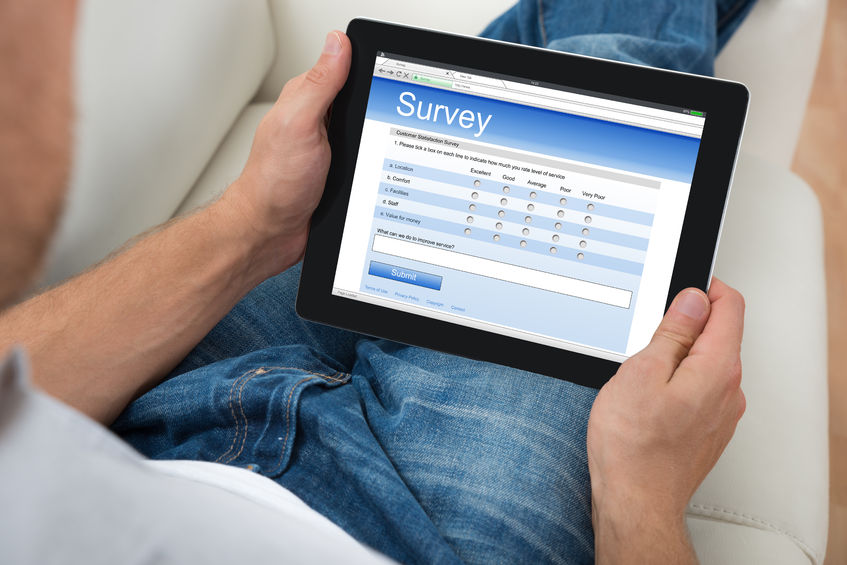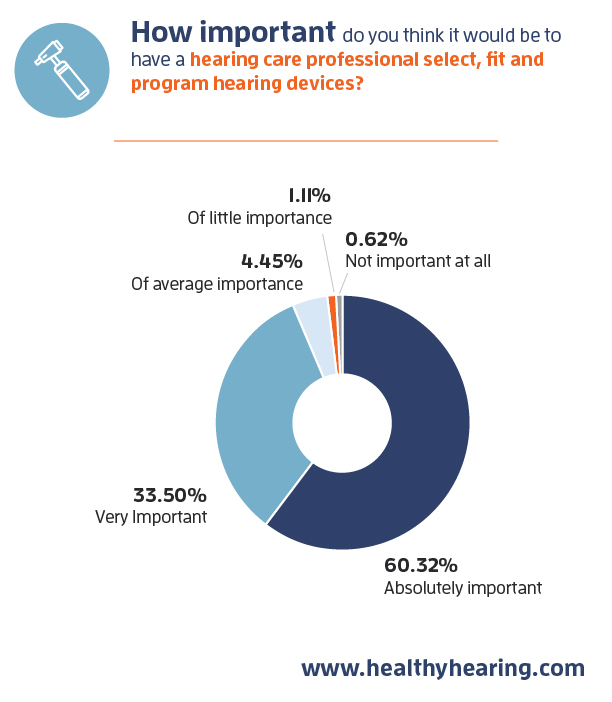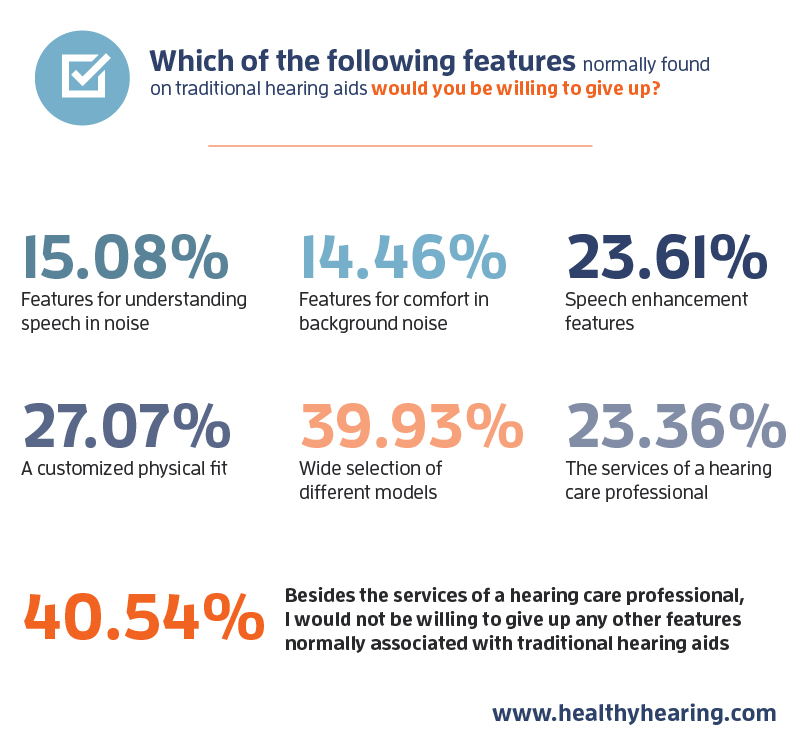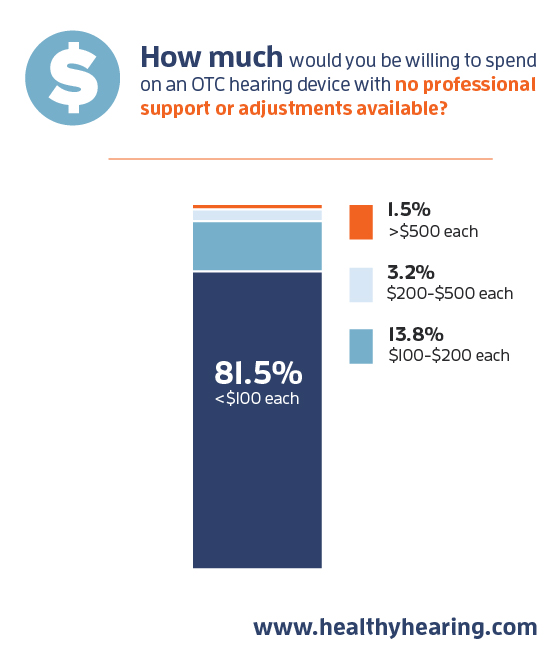[ad_1]
Healthy Hearing conducted a national survey of more than 800 Americans to assess opinions about potential availability of over the counter (OTC) hearing devices and perceived value of professional hearing care services. The results may surprise you.

surprise you.
Recently, in an attempt to make lower-cost hearing devices more accessible, the U.S. Food and Drug Administration (FDA) removed some perceived barriers for purchasing hearing aids by allowing certain types to be purchased over the counter (OTC) without going through a hearing care professional. These changes pave the way for accessibility to hearing devices and hearing amplifiers that are priced below traditional hearing aids, and they are part of a larger conversation around such devices within the FDA and the federal government including the White House and the Senate.
The assumption being made in these discussions is that if we can simply provide a low-cost OTC hearing aid to the public, more consumers will seek hearing care. But is this a valid assumption?
To test the assumption, we conducted a nationwide survey in February 2017. A total of 809 participants aged 50 years and older were selected from a nationwide panel of more than 30 million people that is balanced to be representative of the US population. The large sample size resulted in a small (3.45 percent) margin of error. A small margin of error indicates that our survey is likely to be a representative sample of Americans in this age group.
The vast majority of respondents reported having normal hearing ability. Of those who reported hearing loss, only 28% wore hearing aids. Therefore, the majority of respondents had little hearing aid experience – the presumed target market for OTC hearing aids.
No compromises
For many products, consumers are sometimes willing to compromise on service or try a do-it-yourself (DIY) approach when it comes to potentially saving money. The survey questions aimed to find out if that principle holds true for hearing care. Survey respondents were asked about their willingness to forgo some of the services typically associated with a traditional hearing aid purchase.

Most respondents reported they would not wish to try a DIY approach to many key aspects of hearing care like professional hearing testing, hearing aid selection and hearing aid programming. Only about 23 percent said they would be willing to give up any of the services of a hearing care professional. One respondent reported, “I would not trust an OTC solution and would prefer a health care professional assessing my need for an aid. I also don’t want to just throw my money away on something that may not improve my hearing.”
It’s also clear from the responses that most people would be unwilling to make any compromises when selecting OTC hearing devices.

When it comes to the tangible OTC hearing device and the technology housed inside, the overwhelming majority also reported a desire for all the best features of modern hearing aids without the cost. Fewer than 20 percent of respondents would be willing to spend more than $100 on OTC devices. One survey participant said, “OTC hearing aids need to offer premium hearing for a moderate price.” Another said, “Basically hearing aids are nothing more than amplifiers. I don’t know why they cost so much.” Simply put, when it comes to the technology itself, consumers want to have their cake and eat it too.
Where is the value?
These results may seem contradictory on the surface. How can consumers compromise very little and expect a drastic decrease in the cost of any product? With the price of traditional hearing aids running anywhere from $1000 to more than $4000 for just one device, the cost of less than $100 per device reported as acceptable for OTC devices by most survey respondents seems mythical.
 Much of the cost of hearing aids doesn’t lie in the device itself. Most hearing aids in the U.S. are sold as part of a “bundled” package, meaning the cost of the hearing aid is quoted together with all the associated services of the hearing care professional – from the initial hearing test, consultation, product selection, initial programming and customized fitting to follow-up care, repair warranties and re-programming throughout the life of the product. Within the hearing aid industry, there has been debate over whether this is the best approach for pricing hearing services.
Much of the cost of hearing aids doesn’t lie in the device itself. Most hearing aids in the U.S. are sold as part of a “bundled” package, meaning the cost of the hearing aid is quoted together with all the associated services of the hearing care professional – from the initial hearing test, consultation, product selection, initial programming and customized fitting to follow-up care, repair warranties and re-programming throughout the life of the product. Within the hearing aid industry, there has been debate over whether this is the best approach for pricing hearing services.
Those professionals who advocate “unbundling” the hearing aid device from the service component assert that doing so can help put a definitive price tag on the service component. They feel this will demonstrate to the consumer that the intangible part of the purchase, their expertise and care, is in fact the most valuable part.
It seems from these survey results that consumers intuitively understand this, since fewer than one-quarter would be willing to forgo the services of the professional. One respondent proclaimed, “I would never buy them without being tested by a trained audiologist.” Further, the results tell us that consumers place low value on the tangible device itself, even with the advanced technology offered today – in fact, most of our respondents would pay no more than $100 for an OTC device if they had to do the work themselves.
The future of hearing care
As with most surveys, the results point to a need to dig deeper. For decades, consumers have resisted buying the hearing aids they need, citing cost as a major concern. However, in some countries, such as those in Europe where hearing aids are completely covered under single-payer healthcare, hearing aid adoption is not dramatically higher. It is not clear whether OTC solutions will answer the price objection since they will not address consumer desire for professional services like selection, fitting and follow-up. Additionally, they will not satisfy consumer demand for high-end technology because it is mostly unavailable in OTC devices at the low price consumers are willing to pay.
One thing does remain clear from this survey: consumers value the services of hearing care professionals, and there is still an important place for their work. One participant commented, “I think a professional opinion is needed to select the best hearing device for people with significant hearing loss. OTC aids are OK for people with minor deficits. Spending a large amount of money on OTC aids seems to be a waste of money.” Another said, “Based on my current understanding of hearing loss, I would not be interested in using any device without the personal recommendation of a health care professional.”
While insurers have been reluctant to cover the cost of hearing aids as a product alone or as part of a service bundle, one suitable approach may involve insurance coverage for the service portion of the hearing aid purchase. This would require the industry to give careful thought to what prices are appropriate for the devices themselves and each professional service – consultation, selection, fitting and follow-up care – associated with it.
Some practical advice
If you are currently in need of hearing help, you should know that most hearing care professionals, like the ones listed in our consumer-reviewed directory, will work hard to provide options that fit your budget. These professionals can also help you find financing options and even charitable organizations that can help you afford this investment in your quality of life. Don’t hesitate to take the first step towards better hearing today.
Survey questions and demographics
Q1. If you needed a hearing test, how important do you think it would be to have a hearing care professional thoroughly evaluate your hearing loss and make recommendations?
- 59.70 percent – absolutely important
- 33.62 percent – very important
- 5.19 percent – of average importance
- 0.62 percent – of little importance
- 0.87 percent – not important at all
Q2. If you needed a hearing test, how willing would you be to test your own hearing using either a test on the phone, internet or a smartphone app?
- 10.88 percent – extremely willing
- 16.93 percent – very willing
- 31.15 percent – moderately willing
- 14.83 percent – slightly willing
- 26.21 percent – not at all willing
Q3. If you needed hearing aids, how important do you think it would be to have a hearing care professional select, fit and program hearing devices specifically for your needs?
- 60.32 percent – absolutely important
- 33.50 percent – very important
- 4.45 percent – of average importance
- 1.11 percent – of little importance
- 0.62 percent – not important at all
Q4. If you needed hearing aids, how likely would you be to “program” your own hearing aid using a smartphone app or a computer?
- 8.17 percent – extremely likely
- 16.83 percent – very likely
- 23.27 percent – moderately likely
- 16.21 percent – slightly likely
- 35.52 percent – not at all likely
Q5. Imagine that you decide to purchase a lower cost over the counter (OTC) hearing device. These devices would not be selected or fit by a hearing care professional and there would be no professional support or adjustments available. How much would you be willing to spend on such an OTC hearing device?
- 81.5 percent – Less than $100 per device
- 13.8 percent – Between $100 and $200 per device
- 3.2 percent – Between $200 and $500 per device
- 1.5 percent – More than $500 per device
Q6. If you were to select a lower cost OTC hearing device, which of the following features normally found on traditional hearing aids would you be willing to give up? Select all that apply.
- 15.08 percent – Features that can help you understand speech more clearly in a noisy environment
- 14.46 percent – Advanced, real-time noise reduction features to help you feel more comfortable in background noise
- 23.61 percent – Sophisticated speech recognition and enhancement features
- 27.07 percent – A customized physical fit
- 39.93 percent – A wide selection of different models in all shapes, sizes and colors
- 23.36 percent – The services of a hearing care professional
- 40.54% – Besides the services of a hearing care professional, I would not be willing to give up any other features normally associated with traditional hearing aids.
Q7. Do you currently have any problems with your hearing or trouble understanding what people say?
- 32.88 percent – yes
- 67.12 percent – no
Q8. Do you currently wear hearing aids?
- 9.15 percent – yes
- 90.85 percent – no
Q9. If you have been told you need hearing aids but do not wear them, why not? Indicate only the #1 reason.
- 38.39 percent – Too expensive/no insurance coverage
- 14.29 percent – Don’t like the look of hearing aids
- 26.79 percent – Not sure where to start
- 20.54 percent – I have tried hearing aids but did not like them
Q10. Would you like to tell us anything else related to the topic of hearing aids or potential over the counter (OTC) solutions that could be offered in the future? (This question allowed for open text answers)
Q11. What is your age?
- 33.25 percent – 45-59
- 66.75 percent – 60+
Q12. What is your gender?
- 54.64 percent – female
- 45.36 percent – male
Q13. How much total combined money did all members of your HOUSEHOLD earn last year?
- 2.60 percent – $0-$9,999
- 6.44 percent – $10,000-$24,999
- 15.35 percent – $25,000-$49,999
- 13.49 percent – $50,000-$74,999
- 14.23 percent – $75,000-$99,999
- 9.65 percent – $100,00-$124,999
- 6.93 percent – $125,000-$149,999
- 5.69 percent – $150,000-$174,999
- 2.35 percent – $175,000-$199,999
- 6.31 percent – $200,000 and up
- 16.96 percent – prefer not to answer
[ad_2]
Source link

